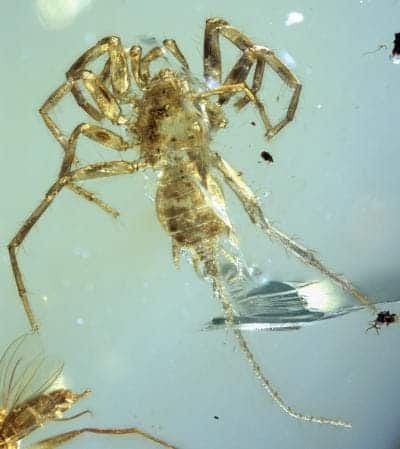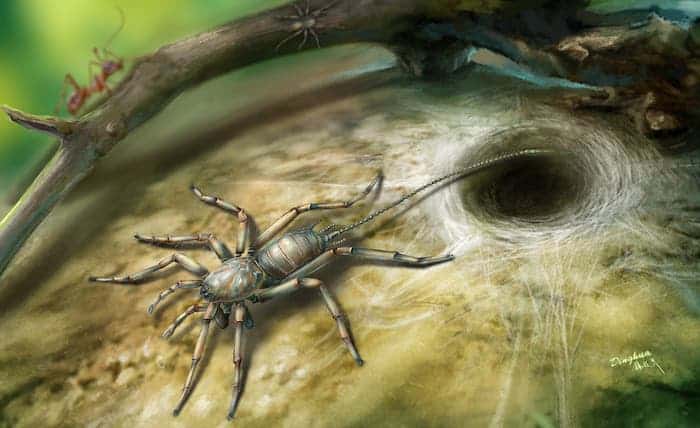Paleontologists have identified an ancient and peculiar spider-like arachnid with a whip-like tail. Although this 100-million-year-old creature has eight legs, fangs, and could spin silk, it was not a spider, but rather a relative that lived alongside spiders. Scientists believe that the ancient species may resolve many loose ends in arachnid evolution.

Specimens belonging to the newly identified species called Chimerarachne yingi were collected from the amber markets of Myanmar, where paleontologists have time and time again come across invaluable fossils. Amber is nature’s time capsule, providing a glimpse of whatever plants or animals became trapped in resin before it fossilized. What’s amazing is that the amber process preserves parts that wouldn’t be conserved through regular fossilization. This is why scientists have been able to find, for instance, things like ticks dining on the feathers of dinosaurs, insects during a courtship dance, 30-million-year-old pristine-looking flowers, or even the oldest mammal blood still preserved in a chubby, 30-million-year-old tick.
“There’s been a lot of amber being produced from northern Myanmar and its interest stepped up about ten years ago when it was discovered this amber was mid-Cretaceous; therefore, all the insects found in it were much older than first thought,” said co-author Paul Selden, a paleontologist at the University of Kansas. “It’s been coming into China where dealers have been selling to research institutions. These specimens became available last year to Nanjing Institute of Geology and Paleontology.”

The C. yingi amber fossils are exquisitely preserved, allowing two different teams of researchers to identify the creature’s morphological features in striking details.
Very much like today’s black widows and huntsman spiders, C. yingi had silk-producing spinnerets. And like modern spiders (the Araneae), C. yingi males had two modified appendages called pedipalps near the head which were used to inseminate females. Unlike the Araneae, however, these creatures possessed a long tail, similar to those of modern scorpions.
It’s this peculiar feature that led the researchers to suspect that C. yingi belongs to a long-extinct arachnid order, known as the Uraraneida, which are differentiated by their tail-like appendage called a telson. Another distinctive feature is that uraraneids had plates on their bellies instead of the squishy abdomens seen in spiders.
These are tiny arachnids, measured about 2.5 millimeters body length, excluding the nearly 3-millimeter-long tail. Selden says the flagelliform appendage acted like a sort of antenna, allowing the creature to sense the environment.
But it’s not entirely certain that C. yingi is a Uraraneid, judging from the silk-producing organs which were more similar to those of modern spiders. The 100-million-year-old spider-like creature may actually belong to its own branch of the evolutionary tree, positioned between spiders and uraraneids. A rather unexpected way scientists could confirm this hunch is by discovering some of C. yingi‘s tailed descendents in the jungle.
“We know a lot about the Burmese biota during the Cretaceous,” he said. “It was a pretty good tropical rainforest, and there are a great many other arachnids we know were there, particularly spiders, that are very similar to the ones you find today in the southeast Asian rainforest. It makes us wonder if these may still be alive today. We haven’t found them, but some of these forests aren’t that well-studied, and it’s only a tiny creature.”
The two studies were published the journal Nature Ecology and Evolution.
Was this helpful?



